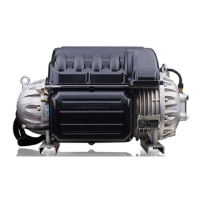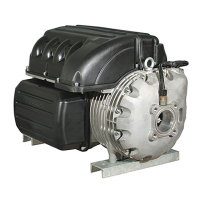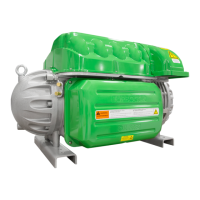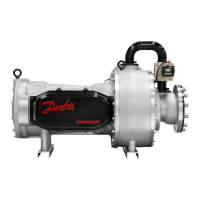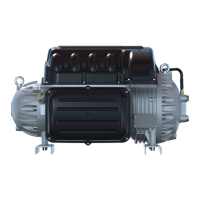
Do you have a question about the Danfoss Turbocor Twin-Turbine TTS Series and is the answer not in the manual?
| Brand | Danfoss |
|---|---|
| Model | Turbocor Twin-Turbine TTS Series |
| Category | Air Compressor |
| Language | English |
Defines the manual's intended use and supported software version.
Outlines the structure and content of the manual's sections.
Explains the meaning of symbols like NOTE and DANGER used in the document.
Explains the coding system used for compressor model identification.
Lists the refrigerants compatible with different compressor series.
Specifies operating and storage conditions, including altitude and humidity limits.
Details how to seal the mains plate to prevent ingress of contaminants.
Describes the packaging design of compressor, motor, and power assemblies.
Provides an overview of the compressor's aerodynamics, motor, and electronics sections.
Describes the flow of refrigerant through the compressor's stages.
Explains how liquid refrigerant is used to cool the compressor's components.
Details the function of IGVs in controlling capacity and flow.
Details the hardware and software for the compressor and bearing/motor controller.
Explains control of motor speed and IGV position for load requirements.
Describes the magnetic bearing system supporting the shaft and controlling position.
Explains the five-axis magnetic bearing system for shaft support.
Provides essential guidelines for proper control wiring techniques.
Describes the specifications and length of the I/O interface cable.
Details requirements for installing the compressor I/O board in an enclosure.
Lists the materials and design features of the compressor construction.
Explains pressure regulation via Alarm and Trip Limits and Pressure Ratio.
Defines the maximum allowable discharge temperature limits for operation.
Lists the suction pressure alarm and trip settings for compressor protection.
Outlines OEM responsibilities for safety, codes, and refrigerant compatibility.
Specifies acceptable voltage and frequency ranges for compressor operation.
Explains configuration of FLA and LRA settings for application.
Mandates installation of input disconnects per safety regulations.
States the motor insulation class rating for the compressor.
Requirements for fast-acting fuses for power electronics protection.
Discusses the optional nature of power line contactors.
Recommends EMI/EMC filters for CE compliance and performance.
Recommends surge suppressors for protection against electrical transients.
Mandates the installation of a 5% impedance line reactor for all compressors.
Recommends harmonic filters for additional current harmonic reduction.
Provides guidelines for proper grounding of all parts and cables.
Recommendations for designing panels housing filters and reactors.
Advises on using shielded cable for mains input to minimize interference.
States the idle power consumption for the compressor series.
Explains how to determine capacity, efficiency, and operational info using software.
Details the guaranteed performance tolerance bands for capacity, efficiency, and power.
Describes the two-stage, variable-speed centrifugal compressor design.
Lists compatible refrigerants for different compressor models.
Details the magnetic bearing system for shaft levitation and support.
Explains VFD for capacity modulation and IGV use for trimming.
Describes the direct-drive, high-efficiency permanent-magnet motor.
Details the microprocessor controller for bearings, speed, and monitoring.
Outlines requirements for system design, component selection, and piping.
Explains the use of economizers for capacity and efficiency improvement.
Specifies requirements for feeding sub-cooled liquid for cooling.
Discusses permanent power connection and line reactor requirement.
Specifies requirements for medium evaporating temperature applications.
Details the low lift option for enabling increased speed at low pressure ratios.
Explains how low pressure ratios can limit compressor capacity.
Presents sound power levels measured for TTS300 and TTS400 compressors.
Specifies minimum clearances required for maintenance and service.
Lists torque specifications for various compressor components and fittings.
Advises on drip trays and insulation for humid environments.
Recommends bracing external piping to minimize vibration transfer.
Suggests an anti-vibration bracket to protect the motor cooling line during transit.
Details procedures for inspecting the compressor upon arrival for damage.
Provides guidance on safe rigging and handling of the compressor.
Instructions for positioning the compressor and ensuring mounting rail levelness.
Requirements for mounting the compressor on a rigid surface or isolation pads.
Instructions for attaching suction, discharge, and motor-cooling connections.
Explains how the I/O board enables control and status communication.
Details the connection of the interface cable to the compressor I/O board.
Addresses improper grounding issues and their impact on components.
Guides on checking interlock terminal resistance and voltage sources.
Describes the connection of power wiring to the compressor.
